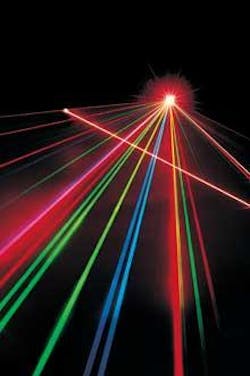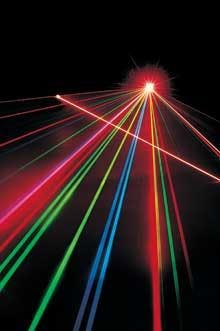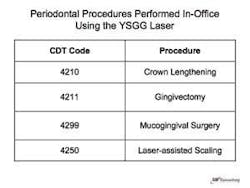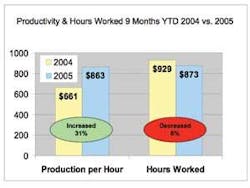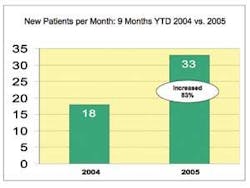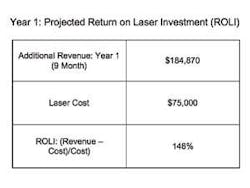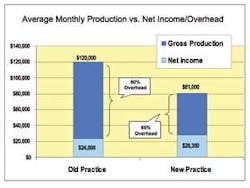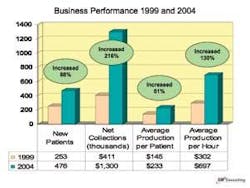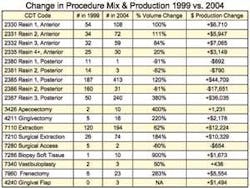Lasers in the office: case studies
As I lecture across the country about many topics on practice management, esthetics, and laser dentistry, the question that keeps popping up is, “How in the world can a dentist make such a big investment in a laser and profit from it?” Well, the way to do it is by working more efficiently. As you will see from the case studies presented here, what has happened in nearly every single case is that using a dental laser has changed the way the dentists practice.
I’ve been teaching for years that the key to overhead control is determined by the time-honored principle of “time is money.” This principle applies differently to lawyers than it does to dentists. If you are a lawyer, then the more time you spend on a case, the more money you will make. In dentistry, it is just the opposite. We don’t charge by time, we charge by procedure. If it takes you 45 minutes to do a MOD composite-resin filling on a posterior tooth, and if you could do that same restoration in 30 minutes or less, you could do more procedures, your office would be more efficient, and you would become more profitable. By using a dental laser for many routine procedures in dentistry, you can eliminate the injection of an anesthetic as well as the waiting time associated with it. You can sit right down and proceed with treatment with no waiting - and that by itself is a huge timesaving over the course of a day, a week, and a year. By coupling this with new procedures that you will add to your treatment mix, the profitability of the investment of a dental laser rises substantially and rapidly for most dental practices.
In addition to the profitability factor, a dental laser is a hot marketing topic with patients. They will perceive your practice as a state-of-the-art, 2006 dental practice. Often, a patient will walk into my office, see my Waterlase MD laser and say, “Wow, it’s about time you dentists have a laser.” You see, your patients go to just about every other medical professional and see their lasers. The ophthalmologist has a laser, the dermatologist has a laser, and the OB-GYNs have a laser. Everyone else is already doing laser surgery. It is about time that dentistry caught up to the rest of the health/science professions. The patient’s reaction translates easily into more word-of-mouth referrals and more new patients.
The advantages of getting a laser are many. I always tell dentists that it is a different kind of dentistry. You can take away a lot of the discomfort and pain, and patients really appreciate that. When it comes to the benefits of a dental laser, patients understand the concept and they want the benefits of minimally invasive, injection-free dentistry. They understand that the dentist has made a commitment to their comfort and to better dentistry. The question is, do you understand it yet? It’s about time that we understand our patients better, give them what they want in terms of state-of-the-art dentistry, with less pain and less trauma. With a dental laser, we can fulfill those goals, be more profitable, and have a more fulfilling dental practice where patients are delighted to come for their dental treatment.
- Dr. Louis Malcmacher
Dentistry: The perfect combination of surgery and art
Waterlase MD Case Study No 1 - Linda Kronick, DMD
Dr. Linda Kronick is one of those dentists you’d like to know better. With a family practice in Norwich, Conn., that focuses on high-tech dentistry, her passion for the profession is a reflection of how she lives: “I love people and want to make them happy.”
As a young adult, Dr. Kronick saw dentistry as a means of combining two strong areas of interest - surgery and art. Growing up in the same town where she now practices, Dr. Kronick spent time learning how to paint, and also worked in a surgical practice where she first learned about dental lasers. She observed the doctor using CO2 lasers in general and oral surgery. She eventually had the opportunity to take courses and see exactly how the laser could work with both hard and soft tissue. “I was spellbound and knew I had to have this in my practice.”
In late 2004, she made the decision to purchase the Waterlase MD (BIOLASE, San Clemente, Calif.) and had it installed to start the New Year. “It’s blown my expectations away,” says Dr. Kronick. “There is so much that I’m doing and so much more to learn.” As her experience and expertise grew over several months, Dr. Kronick’s confidence grew daily with her expanded use of the Waterlase MD. With a focus on restorative dentistry, she is finding the laser much more efficient in doing minimally invasive composite resins, and she routinely uses it for troughing, in lieu of packing retraction cord, prior to final impressions for crown and bridge procedures. “Doing additional procedures during the same visit in the same or different quadrants is easy with the Waterlase MD. Patients are grateful to have one visit rather than several to complete their dental treatment. That’s a plus for everyone - doctor and patient - in this busy world.”
In addition, she is doing periodontal procedures that she used to refer out. “Four perio procedures that I perform routinely have generated $38,000 in additional revenue so far, and I’m just getting started.” (See Table 1.) With the ability to do crown-lengthening procedures at the same time as crown preps, she says, “One can impress immediately following the surgery with unparalleled accuracy. My lab could not believe the clinical results.”
Indeed, the data from her practice indicate that the laser has been the main reason for growth in 2005. As shown in Figure 1, monthly production is up 23 percent, with several months producing more than $100,000 in revenue.
Her hourly production has increased more than $200, from $661 to $863. While hourly production is up 31 percent, hours spent on the job are down 6 percent (see Figure 2). “I’m working smarter per hour,” notes Dr. Kronick, who has worked fewer hours this past year. She used the extra time to learn more about the capabilities of the Er,Cr:YSGG laser.
Dr. Kronick reports her patients’ response to the laser:
“Patients are thrilled because the laser makes their dental treatment quicker, cleaner, and more precise. They say ‘wow’ when I tell them there’s a good chance they’ll have no needle, no pain, and no postoperative numbing or swelling. And they are truly grateful that I’m taking less of their time and don’t have to refer them to a specialist.”
Dr. Kronick has the full support of her staff, many of whom have personally experienced dental work using the laser. “They love raving about it to our patients,” adds Dr. Kronick. The practice philosophy has always been to take time to educate patients and explain what the different technologies can do for them. “Our patients see the benefits and are just amazed at how much better the trip to the dentist can be.” The influence of the laser on referrals also has been significant. Year to date, the practice is seeing 33 new patients per month - nearly double from the average of 18 new patients for the same period a year ago (Figure 3). Two-thirds of the new patients come from referrals, with the balance coming from a small amount of advertising (Yellow Pages and radio ads) that has been constant over the years. “My phone now ‘rings off the hook’ every day.” Part of this can be attributed to the mothers of her young patients. “Kids love it, and their moms run back to day care and schools and tell other moms about it,” says Kronick.
Was it difficult getting started? “Like anything worth pursuing, there’s a learning curve. You need to give yourself permission to take extra time and to make mistakes. At first, you need to be the student before you can be the teacher.” Dr. Kronick also has advice for new users of the Waterlase MD: “Take advantage of the fabulous meetings such as the WCLI (World Clinical Laser Institute) and meet other dentists who will share their laser experiences with you. You will learn a lot, because the lecturers are approachable and aren’t ‘prima donnas.’” Dr. Kronick speaks with authority here, as she lectures to dental students at the University of Connecticut School of Dental Medicine on restorative procedures.
Has the Waterlase MD been a good investment? Dr. Kronick offers an unqualified “Definitely yes” on multiple levels. First, her ROLI (return on laser investment) is forecasted to be 146 percent after one full year of use (see Table 2). Second, this device compares favorably to other opportunities available to dentists. “This laser allows you to increase revenue much more than any whitening system being promoted right now,” comments Dr. Kronick. Third is the professional development. “You will challenge yourself and you will learn more.”
Her final advice is, “Call one of us and see what we’re doing! The Waterlase MD has helped me grow tremendously without having to ‘get bigger.’ I have even more time to enjoy life and want my colleagues to have that same experience.”
Dr. Linda Kronick practices restorative dentistry in Norwich, Conn., and is a clinical associate professor at the University of Connecticut School of Dental Medicine. She may be reached by e-mail at [email protected], or telephone (860) 889-4967.
A Tale of Two Practices
Waterlase MD Case Study No. 2 - Robert “Bo” Turnage, DDS
As a dentist, have you ever wondered what it would be like if you could start all over again and build your dream practice based upon all you have learned over the years? Well, that’s exactly what Robert “Bo” Turnage, DDS, did - after 23 years in clinical practice. His story is significant for newly minted dentists, established practitioners, and older dentists verging on retirement.
After graduating from Loma Linda in 1982, Dr. Turnage purchased a small practice in Palm Springs, where he and his family lived for the next 10 years. With his wife and three small children, he decided to forego California’s fast-paced lifestyle and relocated to Ellensburg, Wash., a rural community between Seattle and Spokane. Dr. Turnage bought an aging practice and spent the next 13 years building it into the largest dental practice in the area. “We were ‘crazy busy,’” recalls Dr. Turnage who, with a 12-person staff, saw from 35 to 50 patients a day. “We had six operatories and an in-house lab. But we also had old-fashioned equipment, including banana chairs, traditional radiography, and air-driven handpieces.”
Over the years, his rural practice production grew to $120,000 per month. “Not bad,” says Dr. Turnage, but his high-volume practice generated tremendous overhead, which was hovering at 80 percent of revenue. “My philosophy was that pumping more patients through the system would lead to greater financial success. I had to work my tail off to keep the practice on track and profitable.” What kept him up at night however, were dual “nagging thoughts.” His kids were nearing high school graduation, and his wife and he thought about relocating to their eventual retirement community “somewhere we could truly enjoy natural beauty each and every day.” At the same time, the pace of work was very stressful, even in a rural setting. “There had to be a better way,” he recalls. Against the wishes of friends, the Turnages decided to move once again, this time to Friday Harbor, a community in the San Juan Islands north of Seattle. During repeated visits to Friday Harbor, they asked local residents where they went for dental care. “What we heard consistently was, ‘Can you get to Seattle?’” The Turnages saw this as an opportunity to bring a unique presentation of dentistry to the community of 7,000 year-around residents that grows to 22,000 in summer. Starting from scratch, Dr. Turnage designed a dental practice from the ground up. He decided on an elegant harbor-view setting with Asian and European antique furniture, dramatic lighting, and lots of artwork. “I wanted patients to feel like they had walked into a high-end spa in Dallas or New York.” Next, he decided to make high technology the focus of his practice as well as the differentiator in the community. “I also wanted patients to feel that they could get the highest level of care without having to travel.” To accomplish this, he purchased a laser. “The Waterlase MD has become the cornerstone of our high-tech patient care approach,” says Dr. Turnage, who also has employed an additional Biolase LaserSmile diode laser, digital X-ray units and pano, microscopes, and ceiling-mounted flat-panel TV/monitors. “We took a risk, not knowing if and when patient acceptance would be there in a relatively small community. It was more expensive to start from scratch, but I wasn’t handicapped by outmoded equipment, systems, or bad habits built in to an existing practice.”
Indeed, the risk is paying off. With only a small sign outside their building and four “conservative” announcements, the practice is attracting both high-end and working-class patients. “We have not only attracted ‘dot-com millionaires,’ but also long-time residents who work in many of the service industries. We also kept our fees reasonable to create even more value to our high-tech approach.” They opened their doors in May 2005 and business has exceeded expectations. After five months, they are averaging 53 new patients per month. Production is at $632 per hour and growing steadily. In contrast to the high-volume rural practice, Dr. Turnage sees eight to 10 patients per day utilizing a smaller and simpler structure that leverages technology. The lower overhead - now at 65 percent which includes some equipment financing - has allowed more money to drop to his net income line, with only two-thirds the production required by his old practice (see Table 1 and Figures 1 and 2).
The reduction in overhead creates net income that far exceeds the lower volume of patients. “Utilizing the laser, I can offer better care to fewer patients. It’s a controlled environment that also gives me freedom to enjoy a more relaxed lifestyle. I no longer feel like I’m going to have a heart attack.” The Waterlase MD technology has greatly contributed to this being possible. “The ability to practice dentistry with a laser is hugely different, better, and more fulfilling.” From bleeding control to treatment options, postop pain control, periodontal, endodontic, surgical, and restorative procedures, Dr. Turnage is doing cases that previously often required referral to a specialist or simply were much less predictable. “Using the laser means fewer complications afterward and much less postop pain.”
Both staff and patients enjoy the benefits of the laser. “My staff really appreciated that the ‘old dog’ was willing to learn something new. It motivates them to achieve a higher standard.” And patients who hear about this laser around town quiz the staff before seeing the dentist to get the inside scoop. They ask questions like, “If the laser gets bumped while the doctor is working, will it cut off my tongue?” The reaction from other local dentists has been mixed: “Some embrace the laser and recognize its potential while others seem skeptical that it could be applicable to their style of practice.” One informal metric has been the increased frequency of his staff needing to fax patient release forms to other dentists, which is occurring multiple times each day. “Patients are actively seeking this technology!” exclaims Dr. Turnage, who likens his new practice to switching from driving a Cadillac to a Formula One race car. “Both are automobiles, and the new one took some time to learn, but it’s a lot more fun. It can do things I had never thought possible, and I now make them part of my everyday practice.”
Dr. Turnage says his experience starting over “where no one knows your name” has helped debunk his previous belief that a successful practice depends heavily on longevity in one community. “I now have time to do the simple but important things,” he says, which include developing a personal relationship with each patient, lunching with his wife, calling his son at college, or planning extended staff meetings to review issues and opportunities. His advice to other dentists can be applied to both new and established practitioners. “For the new dentist, you have the opportunity to go ‘high-tech everything’ and you should do so. The improvements in efficiency and effectiveness are incredible. For others like me who have been in practice for 20-plus years, the laser gave me a new sense of pride in my profession as well as the ability to offer better patient care.” And, he wants to serve as a role model for dentists contemplating retirement: “I am determined that when I retire, my practice will be technologically current for the new dentist.”
With a view of the harbor from both his home and his office, Bo Turnage has turned his dream into reality, with a five-month-old practice literally “in its infancy.” And he’s certainly proven to himself that the third time around is the charm!
Dr. Robert “Bo” Turnage has a boutique dental practice located in Friday Harbor, Wash. He may be reached at (360) 378-4913 or e-mail [email protected].
Take This Job and Love It!
Waterlase MD Case Study No. 3 - Bruce Cassis, DDS
By the end of 1999, Dr. Bruce Cassis had spent 19 years building a successful rural dental practice in Fayetteville, W.Va. “Being of service to people in a positive way” is how Dr. Cassis describes his philosophy. But he was also exhausted enough by the daily routine to admit, “This job stinks!” and instruct his staff, “Don’t ever schedule another kid in my office!”
Fast forward to 2005. Dr. Cassis has had his Waterlase since late 2000 and describes his work life differently: “I’ve never been happier or more satisfied as a dentist. My team - they’re not staff - looks forward to work every day and we have no more long faces. And I’m doing the best kids’ dentistry imaginable.” In fact, his office has become a sought-after place of employment in the community.
What happened? “The laser changed everything,” states Dr. Cassis emphatically. Early in 2000, Dr. Cassis attended a lecture on dental lasers in Charleston led by Dr. Bill Chen. “I ‘got it’ immediately as I was really interested in soft-tissue applications. My cousin, Steve (an ophthalmologist), had long been using lasers for eye surgery and asked, ‘Can’t you use a laser in the mouth?’ There I was using scalpels, which I didn’t like because it’s painful for the patient and full of complications.” He made his decision that night and was the only one of 12 attendees to invest in a laser. “Like my colleagues, I was initially thinking about ‘cost’ more than ‘ROI.’”
Immediately, however, he began generating more revenue and procedures with the laser. “We introduced it to patients regardless of whether we were going to use it on them. And as a practice, we used the laser as a business opportunity rather than just open the door and see what happens.” As shown in Figure 1, net collections have more than tripled when comparing calendar year 2004 to 1999. And 2005 is shaping up to be a record year with production forecasted at $2 million, putting Cassis Dental Center in the top 1 percent of practices nationwide.
What might be surprising is that Fayetteville, W.Va, has a population of 2,000 people. The practice draws from three counties, and has an active patient base exceeding 5,000 people. “We are well-known for pampering our patients, who are everyday, hard-working people,” comments Dr. Cassis. His patients range in age from two to 102. This is in keeping with his practice philosophy of a “lifetime of care” for people’s oral heath. The practice has taken the time to understand local demographics and employment trends. Dr. Cassis noted that 75 percent of residents in his county own their homes; the practice has also successfully connected with employee groups in the area. Creating affordability through patient financing vendors, such as CareCredit (Costa Mesa, Calif.), also has had a big impact. “We have figured out ways to find money for people who desire our services. This is a huge part of our revenue.”
Dr. Cassis has closely documented the types of procedures and frequency with which they are performed. As seen in Table 1, there has been a dramatic shift in the procedure mix since implementing the Waterlase. His experience has led him to work both as an instructor for BIOLASE as well as locally as part of West Virginia’s Rural Health Education Partnership. In that program, dental students from West Virginia University’s Dental School come through for a six-week rotation. Dr. Cassis gives them a half-day training specifically on the laser. His most recent student was trained in the morning of her first week and she was doing laser dentistry in the afternoon. “If you understand a half dozen basic concepts, you can use the laser immediately with a live patient.” What impressed Dr. Cassis even more was the response of his student: “It was awesome. I did the same things I do at school with the drill. The patient asked me, ‘Have you started yet?’ after I had completed the procedure.”
This story is part of the message that Dr. Cassis wants to get out to dentists everywhere. “I believe that laser technology will become ‘the standard of care’ in the next five to seven years. The laser is much more accurate and can pinpoint tissue much better than a bur. I’d jump all over this if I were an older dentist, as it makes procedures easier to do. Younger dentists have the opportunity to really change the course of their careers.” In fact, colleagues who were referring patients to him because the laser could solve their problems are now investing in their own units. “This is good, because it raises the level of care in our community.”
Dr. Cassis is grateful for what the Waterlase has done for his practice and his patients. “On behalf of the eight people who work here - our TEAM - I can say that the laser has changed each of our lifestyles by helping us be more successful at what we do.” Looking back at his decision to get into laser dentistry, he offers this conclusion: “I’m a much better dentist than I was six years ago.”
Dr. Bruce Cassis is an adjunct professor at the West Virginia University School of Dentistry, and serves as an instructor/facilitator for the West Virginia Rural Health Education Partnership. He maintains a private practice in Fayetteville, W.Va., and may be reached at (304) 574-0424 or e-mail [email protected].
Postscript: Summary of the case studies, by Shareef Mahdavi
As a researcher, what I found most interesting during the interview process was the professional passion displayed by these dentists. They were not saddled by the burnout mentality, which is so typical of dentists after practicing for 15 to 20 years. To the contrary, these users of the Waterlase technology have an enthusiasm for work that likely exceeds their first days in practice. Their incorporation of laser technology has positively impacted them emotionally as well as financially, and there is a joy that’s been expressed in the impact they are having on patients, including those who have been previously fearful of dentistry or those who are naturally challenging to work with, such as children. At their core, these dentists are amazed at how the laser has transformed the way they deliver dental care to their patients and want others in their profession to understand just how significant a change the laser can make to one’s practice and one’s person.
Shareef Mahdavi is president of SM2 Consulting, advising medical device companies and providers on how to increase adoption of new technology. He has spent 20 years in device marketing, and was responsible for the launch of the laser technology used for LASIK in the United States. As a consultant to BIOLASE, he is writing a series of case studies focusing on dentists who have integrated the Waterlase MD technology into their practices. Contact Mahdavi at (925) 425-9963, or e-mail [email protected].
